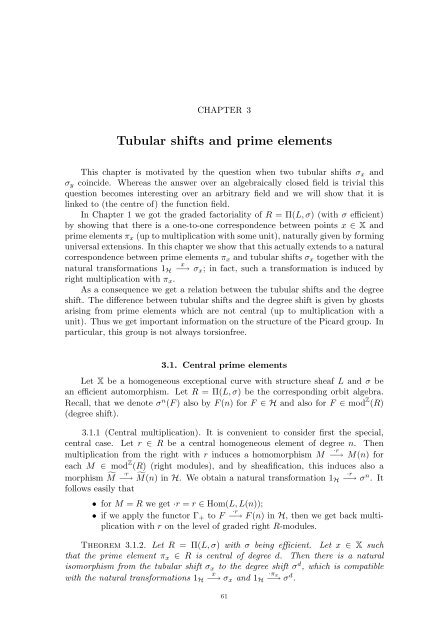MEMOIRS
MEMOIRS
MEMOIRS
- No tags were found...
You also want an ePaper? Increase the reach of your titles
YUMPU automatically turns print PDFs into web optimized ePapers that Google loves.
CHAPTER 3Tubular shifts and prime elementsThis chapter is motivated by the question when two tubular shifts σ x andσ y coincide. Whereas the answer over an algebraically closed field is trivial thisquestion becomes interesting over an arbitrary field and we will show that it islinked to (the centre of) the function field.In Chapter 1 we got the graded factoriality of R =Π(L, σ) (withσ efficient)by showing that there is a one-to-one correspondence between points x ∈ X andprime elements π x (up to multiplication with some unit), naturally given by forminguniversal extensions. In this chapter we show that this actually extends to a naturalcorrespondence between prime elements π x and tubular shifts σ x together with thexnatural transformations 1 H −→ σ x ; in fact, such a transformation is induced byright multiplication with π x .As a consequence we get a relation between the tubular shifts and the degreeshift. The difference between tubular shifts and the degree shift is given by ghostsarising from prime elements which are not central (up to multiplication with aunit). Thus we get important information on the structure of the Picard group. Inparticular, this group is not always torsionfree.3.1. Central prime elementsLet X be a homogeneous exceptional curve with structure sheaf L and σ bean efficient automorphism. Let R =Π(L, σ) be the corresponding orbit algebra.Recall, that we denote σ n (F )alsobyF (n) forF ∈Hand also for F ∈ mod Z (R)(degree shift).3.1.1 (Central multiplication). It is convenient to consider first the special,central case. Let r ∈ R be a central homogeneous element of degree n. Thenmultiplication from the right with r induces a homomorphism M −→ ·rM(n) foreach M ∈ mod Z (R) (right modules), and by sheafification, this induces also a·rmorphism ˜M −→ ˜M(n)·rinH. We obtain a natural transformation 1 H −→ σ n . Itfollows easily that• for M = R we get ·r = r ∈ Hom(L, L(n));• if we apply the functor Γ + to F −→ ·rF (n) inH, then we get back multiplicationwith r on the level of graded right R-modules.Theorem 3.1.2. Let R = Π(L, σ) with σ being efficient. Let x ∈ X suchthat the prime element π x ∈ R is central of degree d. Then there is a naturalisomorphism from the tubular shift σ x to the degree shift σ d , which is compatiblex·πwith the natural transformations 1 H −→ σ x and 1xH −→ σ d .61
















